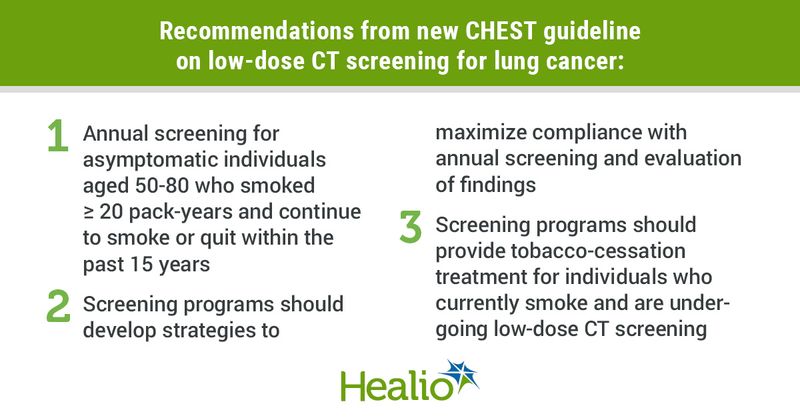CHEST issues new guideline on benefits, harms, use of low-dose CT screening for lung cancer
Click Here to Manage Email Alerts
The American College of Chest Physicians released a new guideline and expert panel report that contains recommendations and updates the evidence base for the benefits, harms and implementation of low-dose CT screening for lung cancer.
The new guideline provides recommendations on the selection of individuals eligible for screening, the quality of imaging and image interpretation, management of screen-detected findings and the effectiveness of smoking-cessation interventions, according to a press release issued by CHEST.

“Over the past few years there has been new research published that has increased our understanding of the benefits and harms of lung cancer screening,” Peter J. Mazzone, MD, MPH, FCCP, director of the Lung Cancer Program and Lung Cancer Screening Program for the Respiratory Institute at the Cleveland Clinic, told Healio. “In addition, there has been more experience gained with running high quality screening programs. We felt that this new information should be included in our guideline recommendations.”
According to the panel, annual screening with low-dose CT should be offered to:

- asymptomatic individuals aged 55-77 years with a smoking history of 30 pack-years or more who continue to smoke or quit within the past 15 years;
- asymptomatic individuals aged 50-80 years who do not meet the above age and smoking criteria with a smoking history of 20 pack-years or more who continued to smoke or quit within the past 15 years; and
- asymptomatic individuals who meet neither of the above age or smoking criteria but are projected to have a high lung cancer screening net benefit based on results of clinical risk prediction calculations and life expectancy estimates or based on life-year gained calculations.
The panel does not recommended low-dose CT screening for lung cancer for individuals with less than 20 pack-years of smoking or those aged younger than 50 years or older than 80 years, or who quit smoking more than 15 years ago and are not projected to have a high net benefit from screening based on risk prediction or life-year gained calculations. Screening is also not recommended for individuals with comorbidities limiting their life expectancy and adversely impacting their ability to tolerate evaluation or tolerate treatment of early-stage screen-detected lung cancer, according to the guideline.
According to the document, the panel recommended the following for implementation of low-dose CT screening:
- screening programs should develop strategies to determine whether patients have symptoms suggesting lung cancer so symptomatic individuals receive appropriate diagnostic testing regardless of whether they meet the criteria for screening eligibility;
- screening programs should develop strategies to provide effective counseling and shared decision-making before the low-dose CT screening exam;
- screening programs should define a positive test on low-dose CT based on the size of a detected solid or partially solid lung nodule (threshold of 4 mm, 5 mm or 6 mm in diameter);
- screening programs should develop strategies with the aim to maximize compliance with annual screening and evaluation of findings;
- screening programs should develop comprehensive approaches to lung nodule management, including multidisciplinary access and algorithms for managing small solid nodules, large solid nodules and sub-solid nodules;
- screening programs should develop strategies that minimize overtreatment of potentially indolent lung cancers;
- screening programs should provide evidence-based tobacco cessation treatment for individuals who report current smoking and are undergoing screening;
- screening programs should follow protocols set by the American College of Radiology/Society of Thoracic Radiology for performing low-dose chest CT scans;
- screening programs should use structured reporting systems to report low-dose CT scan results;
- screening programs should develop strategies to guid the management of non-lung nodule findings; and
- screening programs should utilize data collection and reporting tools to assist with quality improvement initiatives and reporting to the National Registry.
“These guidelines help to clarify, for patients and providers, who should receive screening for lung cancer and who should not. They also help those running screening programs by describing the elements that should be in place in order to provide patients with the highest quality care,” Mazzone said. “Additional research will help us to better identify individuals who are most and least likely to benefit from being screened; help us ensure that screening is available in an equitable manner; help us refine the way we communicate with individuals about screening; help us to ensure compliance with annual screening and with the follow-up of concerning findings on the screening exam; and to improve the interventions available to help those being screened who are still smoking to quit.”
For more information:
Peter J. Mazzone, MD, MPH, FCCP, can be reached at mazzonp@ccf.org.
Reference:
Editor’s note: This article was updated on Aug. 18, 2021, with quotes from Dr. Mazzone
